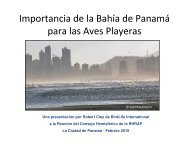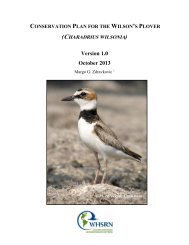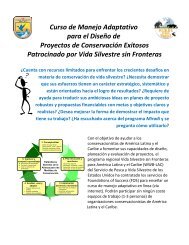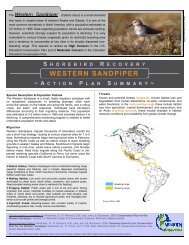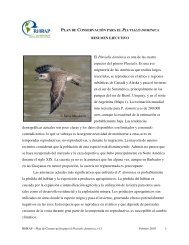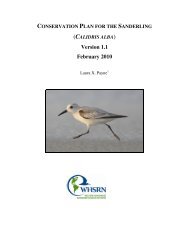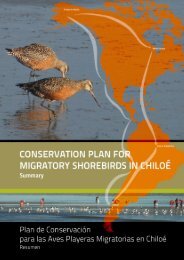MANOMET, INC - Western Hemisphere Shorebird Reserve Network
MANOMET, INC - Western Hemisphere Shorebird Reserve Network
MANOMET, INC - Western Hemisphere Shorebird Reserve Network
You also want an ePaper? Increase the reach of your titles
YUMPU automatically turns print PDFs into web optimized ePapers that Google loves.
Executive Summary<br />
While recent years have seen several efforts throughout all of the Americas to conserve<br />
habitats and sustain populations and species of shorebirds, many of these continue to suffer<br />
serious declines. That is why the Manomet Center for Conservation Sciences, beginning in<br />
September 2007, has been designing and implementing its <strong>Shorebird</strong> Recovery Project, with<br />
the aim to restore and maintain populations and species of shorebirds with conservation<br />
problems (both Nearctic and Neotropical ) throughout the Americas. The <strong>Western</strong><br />
Hemispheric <strong>Shorebird</strong> <strong>Reserve</strong> <strong>Network</strong> is the key tool of the site-based conservation<br />
aspect of this project.<br />
The project has three focus areas: Arctic, Northwest Mexico and Patagonia. This last region<br />
is of strategic importance as it concentrates key habitat for the survival of non-breeding<br />
populations of many species such as the nearctic Red Knot (Calidris canutus rufa), the<br />
Hudsonian Godwit (Limosa haemastica) and the White-rumped Sandpiper (Calidris<br />
fuscicollis). The region also hosts endemic shorebird species as the threatened Magellanic<br />
Plover (Puvinallus socialis)<br />
This present plan is the result of a participatory process that began during the month of<br />
October 2009 in the city of Rio Gallegos, Argentina. Applying the methodology for the<br />
Conservation Area Planning (CAP, with several consultations and discussions with key<br />
stakeholders, this plan proposes objectives and priority strategies for management,<br />
conservation, research and monitoring of shorebirds and their habitats in the Patagonia.<br />
We identified six conservation targets (habitats) and for each, the shorebirds conservation<br />
and recovery actions for Patagonia: 1) Tidal Flats, 2) Sand Beaches, 3) Pebble Beach, 4)<br />
Restingas (abrasion platforms), 5) Inland Wetlands and 6) Coastal Grasslands. Based on<br />
the analysis performed, it was determined that the global conservation status of these<br />
elements is “Good.” However, after identifying a total of eight main threats affecting two or<br />
more of the above targets, the threat status for Patagonian shorebirds was determined to be<br />
“High.” The five most severe threats that are causing loss and / or degradation of existing<br />
and potential habitat for shorebirds in this area are: unregulated urban development:<br />
petroleum extraction activities; introduction of exotic species; livestock and agriculture;<br />
and unorganized recreational activities.<br />
Priority strategies designed in this plan include actions such as institutional strengthening;<br />
training in best practices for the production sectors; research on species ecology, population<br />
monitoring, land use, solid waste management and exotic species; communication,<br />
environmental education and development of social marketing strategies.<br />
The implementation of this plan will improve and / or maintain the health of conservation<br />
targets (focal and nested); eliminate or significantly reduce threats to degrade the health of<br />
habitats and populations of shorebirds that use them; prevent future degradation and<br />
strengthen the response capacity of key actors and stakeholders. This will contribute to the<br />
sustained success in the conservation of shorebirds and their habitats throughout Patagonia.<br />
2




